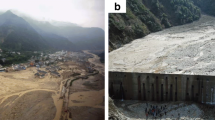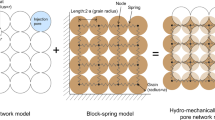Abstract
Particles breakage occurs in many industrial applications. During the last decade many works have been devoted for modelling and simulating such processes. A new and innovative procedure of empirical comminution functions for Discrete Element Method (DEM) simulations (Kalman et al. in Granul Matter 11(4):253–266, 2009) posed the question how to introduce the fragments of the broken particle back into the computational domain. Daughter particles (Fragments) spawning and interaction imposes several problems during DEM simulation. Some of the main problems are: seeding (allocating) daughter particles and their initial conditions i.e. fragments locations, velocities and physical properties. This work focuses on the daughter particles seeding and the interaction between “sibling” particles for spherical particles. Fragments spawning and interaction algorithm for particle breakage during DEM simulation was developed. The algorithm enables prediction of particle comminution/attrition processes using DEM applications. The new algorithm can utilize any breakage function allowing unlimited fragment size fractions. In the proposed model, sibling particles can overlap without increasing the energy of the system in the simulation. Particle-particle and particle-wall interactions are calculated using the standard DEM calculations. Daughter particles interactions were calculated using the developed temporary contact radius model. The model was utilized to predict particle comminution in jet milling and particle attrition during pneumatic conveying with great successes.
Similar content being viewed by others
References
Kalman H., Rodnianski V., Haim M.: A new method to implement comminution functions into DEM simulation of a size reduction system. Granul. Matter 11(4), 253–266 (2009)
Zhu H.P., Zhou Z.Y., Yang R.Y., Yu A.B.: Discrete particle simulation of particulate systems: a review of major applications and findings. Chem. Eng. Sci. 63, 5728–5770 (2008)
Kafui K.D., Thornton C.: Numerical simulations of impact breakage of a spherical crystalline agglomerate. Powder Technol. 109, 113–132 (2000)
Mishra B.K., Thornton C.: Impact breakage of particle agglomerates. Int. J. Miner. Process. 61(4), 225–239 (2001)
Antonyuk S., Khanal M., Tomas J., Heinrich S., Mörl L.: Particulate processes: a special issue of chemical engineering and processing impact breakage of spherical granules: experimental study and DEM simulation. Chem. Eng. Process. 45, 838–856 (2006)
Papadopulos, D.G., Teo, C.S., Ghadiri, M.: Attrition of common salt. In: 3rd World Congress on Particle Technology, AIChE (1998)
Han T., Kalman H., Levy A.: DEM simulation of particle comminution in jet milling. Part. Sci. Technol. 20, 325–340 (2003)
Han T., Levy A., Kalman H.: DEM simulation of salt during dilute-phase pneumatic conveying. Powder Technol. 129, 92–100 (2003)
Buchholtz V., Freund J.A., Pöschel T.: Molecular dynamics of comminution in ball mills. Eur. Phys. J. B 16, 169–182 (2000)
Pöschel T., Schwager T.: Computational Granular Dynamics—Models and Algorithms. Springer, Germany (2005)
Aström J.A., Herrmann H.J.: Fragmentation of grains in a two-dimensional packing. Eur. Phys. J. B. 5, 551–554 (1998)
Potapov A.V., Campbell C.: Computer simulation of impact-induced particle breakage. Powder Technol. 81, 207–216 (1994)
Khanal M., Schuberta W., Tomas J.: Discrete element method simulation of bed comminution. Miner. Eng. 20(2), 179–187 (2007)
Rozenblat, Y., Portnikov, D., Levy, A, Kalman, H., Aman, S., Tomas, J.: Strength distribution of particles under compression. Powder Technol. (2011, in Press)
Rozenblat, Y.: Investigating Size Reduction Functions for DEM Applications. Ph.D. thesis, Ben Gurion University, Israel, (internal communication) (2009)
Brosh T., Levy A.: Modelling of heat transfer in pneumatic conveyer using a combined DEM-CFD numerical code. Dry. Technol. 28, 155–164 (2010)
Brosh T., Kalman H., Levy A.: Implementation of comminution functions in DEM simulation of dilute-phase pneumatic conveying. Granul. Matter 13(2), 175–181 (2010)
Brosh, T., Levy, A., Kalman, H., Ricard, F., Peyron, I.: Implementation of comminution functions in jet-mill DEM simulation. In: The World Congress on Particle Technology (WCPT6), Nuremberg (2010)
Vogel L., Peukert W.: Characterisation of grinding-relevant particle properties by inverting a population balance model. Particle Particle Syst. Charact. 19, 149–157 (2002)
Petukhov Y., Kalman H.: Empirical breakage ratio of particles due to impact. Powder Technol. 143(144), 160–169 (2004)
Author information
Authors and Affiliations
Corresponding author
Rights and permissions
About this article
Cite this article
Brosh, T., Kalman, H. & Levy, A. Fragments spawning and interaction models for DEM breakage simulation. Granular Matter 13, 765–776 (2011). https://doi.org/10.1007/s10035-011-0286-z
Received:
Published:
Issue Date:
DOI: https://doi.org/10.1007/s10035-011-0286-z




